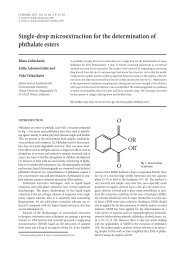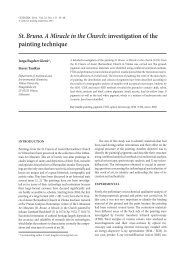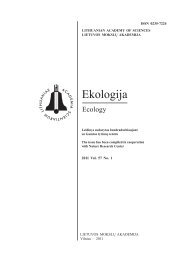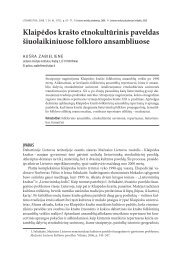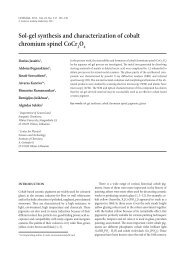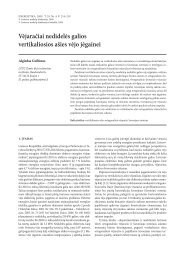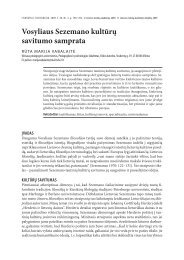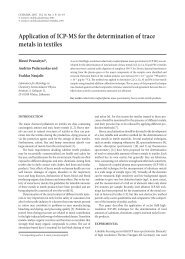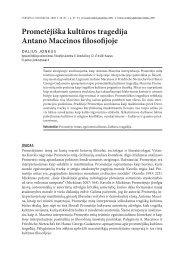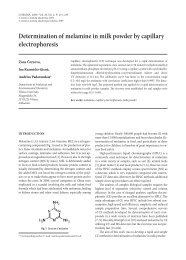calculation results of chemical thermodynamic equilibrium of ...
calculation results of chemical thermodynamic equilibrium of ...
calculation results of chemical thermodynamic equilibrium of ...
You also want an ePaper? Increase the reach of your titles
YUMPU automatically turns print PDFs into web optimized ePapers that Google loves.
energetika. 2010. T. 56. Nr. 2. P. 85–91© lietuvos mokslų akademija, 2010© lietuvos mokslų akademijos leidykla, 2010<strong>calculation</strong> <strong>results</strong> <strong>of</strong> <strong>chemical</strong> <strong>thermodynamic</strong><strong>equilibrium</strong> <strong>of</strong> produced gasJosé Luiz Marão JuniorLithuanian Energy Institute,Breslaujos g. 3,LT-44403 Kaunas, LithuaniaE-mail: jose.marao@mail.lei.ltThe <strong>chemical</strong> <strong>thermodynamic</strong> behaviour <strong>of</strong> gas tars under temperature changes in the systemwas evaluated. The initial composition and caloricity <strong>of</strong> the mixture were determinedaccording to biomass and waste gasification. The <strong>chemical</strong> composition was simulated applyingthe Gibbs free energy <strong>thermodynamic</strong> <strong>equilibrium</strong> <strong>calculation</strong> with the help <strong>of</strong> acomputational program. The obtained <strong>results</strong> were compared with the <strong>results</strong> found in theliterature, identifying tar conditioning systems’ characteristics and the impact <strong>of</strong> initialmixture changes at a varying air equivalence and steam-to-carbon ratios. It was found efficientto use water vapour at temperatures <strong>of</strong> 900–1050 K, whereas at lower temperatures amore intensive oxidation should be used.Key words: gasification, tar, gibbs energy, thermodinamic <strong>equilibrium</strong>1. IntroductionRecently, gasification <strong>of</strong> non-food biomass and waste has gaineda new potential as one <strong>of</strong> the new energy sources that reducedependence on fossil fuels. Gasification is a simple andreliable way to produce a calorific fuel. However, gasificationsystems need to meet equipment and environmental requirementsto avoid unwanted byproducts such as tars, particulates,alkali, sulfur and ammonia [1]. In the present study, therole <strong>of</strong> particulates and tars in gas producers was investigated.Table 1 shows tar and particulate level requirements <strong>of</strong> fuelcharacteristics according to equipments and end use devices.In the literature, there are several definitions <strong>of</strong> tars. Inthis study, tars were considered as condensable organic compoundswith a viscous black or dark brown liquid aspect. Itis mainly formed by a mixture <strong>of</strong> aromatics such as toluene,phenol, two- and more ring polycyclic aromatic hydrocarbons(PAH) such as naphthalene and anthracene [2, 3].On the one hand, separation <strong>of</strong> tar and particles from syntheticfuels to achieve end-use requirements can be done withTable 1. End-use devices and process equipment requirements [1, 2]End-useTar,mg/Nm 3Particulate,mg/Nm 3Particulatesize, μmInternal combustion engine 10–50 50 –Gas turbine 5 15 5Synthetic gas production – 0.02 –Compressors 50–500 – –mechanical separators such as cyclones, bag filters, scrubbersand electrostatic precipitators. On the other hand, when tarsare eliminated from synthetic gases, the fuel heating valuecan be drastically reduced; this means that these losses maynot justify the use <strong>of</strong> such equipment. So, there is a need t<strong>of</strong>ind methods and processes to re-use the heating value <strong>of</strong> tarsby <strong>chemical</strong>ly changing its composition, cracking them intosmaller fractions such as permanent gases which are betterburnable, do not recombine at temperature changes and donot damage end-use devices.The present work considers a <strong>thermodynamic</strong> evaluationprocess to study the tar-conditioning behaviour. The<strong>chemical</strong> kinetic models <strong>of</strong> gaseous phase hydrocarbonscan be generalized into three types: empirical, molecularand mechanistic [4]. Empirical investigations have a disadvantagedue to time and cost factors and the level <strong>of</strong>uncertainty <strong>of</strong> the available equipment. Molecular modelscan in some cases <strong>of</strong>fer quick and reliable approaches. However,only mechanistic models can represent properly areal <strong>chemical</strong> phenomenon with a high level <strong>of</strong> accuracy.But, creating reliable mechanistic models for large hydrocarbonspecies is very difficult and requires very extensiveexperimental work (depending on the number and size <strong>of</strong>species to be analyzed). Thus, considering this limitation,in this work we chose a molecular model for determiningthe <strong>thermodynamic</strong> <strong>equilibrium</strong> <strong>of</strong> a gas phase mixture <strong>of</strong>hydrocarbon, nitrogen and tar species and its relation totemperature.
86José Luiz Marão Junior2. MethodologyTo solve the problem <strong>of</strong> <strong>chemical</strong> <strong>equilibrium</strong>, the programcode Cantera was chosen [5] which uses the Villars–Cruise–Smith algorithm. It was chosen because it’s well situated tohandle multiphase problems [6, 7] by adding and removingcondensed species from the simulation at each step <strong>of</strong> <strong>calculation</strong>.It solves the Gibbs minimization energy G(ξ) problemwith constant pressure and temperature as a function<strong>of</strong> reaction-extent variables or stoichiometric-vector multipliersξ:This equation is the same as the <strong>equilibrium</strong> condition<strong>chemical</strong> formulation:where is the <strong>chemical</strong>-potential vector with entries μ i, andN T is the transposed N stoichiometric matrix:(1)(2)N = N s× N r, (3)where N sis a table with entries v ijrepresenting the stoichiometriccoefficient <strong>of</strong> species i (i = 1, 2,… N ′ ) in the stoichiometricvector j (j = 1, 2,…, R), and N rsis a column <strong>of</strong> stoichiometricvectors,R = N ′ s – N e , (4)N ′ s is the number <strong>of</strong> species, excluding inert species, and N e isthe number <strong>of</strong> atomic elements.A linear transformation to relate reaction variables tocomposition variables which constrain the mass conservation<strong>of</strong> the atomic elements with N isn = n* + Nξ, (5)where n* is a known set <strong>of</strong> mole numbers initiated with guesses.The <strong>equilibrium</strong> composition n and the minimum G(ξ)are the <strong>results</strong> <strong>of</strong> m iterations using a second-order variationscheme ( ) for a previously selected set <strong>of</strong> gaseous,li quid and solid species. The mole number <strong>of</strong> these speciesis predicted by a simplex <strong>calculation</strong> satisfying mass constraints.Basically, a quadratic approximation <strong>of</strong> the functions Q(ξ)to G(ξ) is constructed, matching them in terms <strong>of</strong> first derivativesG(ξ) with respect to ξ and n. When the minimum<strong>of</strong> Q(ξ) is achieved, it is possible to create a set <strong>of</strong> N rlinearequations represented by the Hessian matrix H: N r× N rin itstransposed form:∂ξ = H –1 µ i. (6)So equations (6) and ∂n = N∂ξ can be solved; then the<strong>results</strong> <strong>of</strong> ξ = ξ * + ∂ξ and equation (5) represent the minimumQ(ξ). When the new calculated values ξ and n are getting closerto the previously calculated ξ * and n * , it means that theminimum G(ξ) is up to be achieved. Thus, a repletion <strong>of</strong> thisprocedure converges the solution <strong>of</strong> the <strong>equilibrium</strong> compositionequivalent to the minimum G(ξ). A more detailedinformation about this procedure is presented by Smith andMissen [8].2.1. Problem formulationThe gas inlet for this investigation was assumed a constantsource with a higher heating value (HHV) fuel 5 MJ/Nm 3including the heat <strong>of</strong> the combustion <strong>of</strong> tars. This value waschosen because it represents a typical heating value for a biomassand tire gasification unit [9].Accordingly, the tar fraction was assumed to be a valuewhich completes the fixed HHV <strong>of</strong> the fuel, and the nitrogenfraction refers to the amount <strong>of</strong> gas to complete the volume<strong>of</strong> the mixture. Besides, the tar species in the inlet gas wasconsidered, to be the two-ring aromatic hydrocarbon naphthalene(C 10H 8).The molar percentage <strong>of</strong> H 2per CO in the producer gas inall investigations was assumed to be 7.1% and 9%, respectively,according to experimental <strong>results</strong> <strong>of</strong> tire gasification underthe sub-stoichiometric air ratio α = 0.2 [9]. These values werechosen to give a more realistic aspect to the tar case simulationand because they represent a case in which permanent gasfraction corresponds to about 40% <strong>of</strong> the HHV <strong>of</strong> the mixture.In such circumstances, a conditioning system is essentialto achieve the optimal output in the process that uses thesegases to produce electricity, for example, through an internalcombustion engine.Thus, we investigated the behaviour <strong>of</strong> tar species changingthree process characteristics: thermal cracking (temperaturevariations), steam reforming (variations <strong>of</strong> steam tocarbon ratio – H 2O/C) and partial oxidation (variations <strong>of</strong>the air equivalence ratio ER).In addition, the following assumptions were adopted inthis simulation:– adiabatic process;– a multiphase problem was considered, i. e. soot formationwas taken into account in the <strong>calculation</strong>s;– sulfur compounds were not considered.Besides, there is an international standard for tar samplingand analyzing [10]; it is very difficult to determine thefractions <strong>of</strong> each tar species in producer gases. So, the tar speciesincluded in this model were considered the same as tirepyrolysis experiments identified by Chen et al. [11]. Table 2shows the <strong>chemical</strong> species included in the models.In the model, soot was considered as an unwanted byproduct<strong>of</strong> combustion, represented by large PAH (C/H < 2) speciesand solid carbon. Due to this simplification, the outputtar and soot were analyzed together as both are unwantedcalorific products.
<strong>calculation</strong> <strong>results</strong> <strong>of</strong> <strong>chemical</strong> <strong>thermodynamic</strong> <strong>equilibrium</strong> <strong>of</strong> produced gas87Table 2. Chemical species considered in the modelGroupCompoundsHydrogen and oxygen compoundsH, H 2 , O, O 2 , OH, H 2 O, HO 2 , H 2 O 2 , HCONitrogen compoundsN, N 2 , NH, NH 2, NH 3 , N 2 H, NO, NO 2 , N 2 O, HNO, CN, HCN, H 2 CN, HCNH, HCNO, HOCN, HNCOHydrocarbons CH, CH 2 , CH 3 , CH 4 , C 2 H, C 2 H 2 , C 2 H 3 , C 2 H 4 , C 2 H 5 , C 2 H 6 , C 3 H 7 , C 3 H 8 , C 4 H 6 , C 5 H 6Hydrocarbon – tars C 6 H 6 , C 6 H 5 OH, C 7 H 8 , C 7 H 8 O, C 8 H 10 , C 9 H 8 , C 10 H 8 , C 12 H 10 , C 13 H 10 , C 14 H 10 , C 16 H 10 , C 20 H 12 , C 22 H 14 , C 24 H 12Other organic compoundsCH 2 O, CH 2 OH, CH 3 O, CH 3 OH, HCCO, CH 2 CO, HCCOH, CH 2 CHO, CH 3 CHOInorganic carbon compounds C(s), CO, CO 22.2. Program code and <strong>thermodynamic</strong> databaseAs mentioned before, the <strong>thermodynamic</strong> <strong>equilibrium</strong> solverused in this work was the Cantera program code – an opensource code written in Python – which uses the Villars–Cruise–Smithalgorithm to solve the Gibbs <strong>chemical</strong> <strong>equilibrium</strong>problem. The relative error tolerance considered was 1 × 10 –9and the log level = 4. Micros<strong>of</strong>t Excel was used as a post-processor.The database evaluated in the <strong>calculation</strong>s was the ThirdMillennium Ideal Gas and Condensed Phase Thermo<strong>chemical</strong>Database for Combustion [12], containing <strong>thermodynamic</strong>properties <strong>of</strong> 508 molecular species; however, only those presentedin Table 2 were considered important for this investigation.Originally this database is not on the format used inCantera, so it had to be converted to this format by the author<strong>of</strong> this paper.3. Results and discussionThe <strong>thermodynamic</strong> <strong>equilibrium</strong> <strong>results</strong> were calculated accordingto several reactor-simulated temperatures varyingfrom 600 K and 1600 K. These temperatures were chosen becauseusually tar mixtures condense at temperatures below600 K, and higher temperatures are limited by the processeconomic and reliability factor. The expected tar cracking reactionsshould occur due to the process called thermal cracking[3, 13, 14], which can be represented as:C nH m⇔ nC + ½ mH 2. (7)It was observed that the maximum HHV remained stableafter reaching certain temperatures. The beginning <strong>of</strong>heat value peaks was identified in the range 900–1000 K and900–1100 K in the cases <strong>of</strong> enhancing thermal cracking withH 2O/C and ER, respectively. Furthermore, these values rangefrom 4.5 to 5 MJ/Nm 3 and from 2 to 4.5 MJ/Nm 3 , respectively,in H 2O/C and ER cases. The maximum HHV value is converselyproportional to the process H 2O/C and ER (Figs. 1and 2).From the point <strong>of</strong> view <strong>of</strong> cracking tars, ER cases eliminatetars considerably at temperatures <strong>of</strong> 900–1000 K (Fig. 3),while H 2O/C cases present similar <strong>results</strong> in temperatures <strong>of</strong>900–1050 K (Fig. 4). Increasing the ER ratio resulted in anexpressive tar fraction reduction at temperatures up to 800 K,while increasing the H 2O/C ratio showed a weaker influence.Steam reforming positively enhances the fraction <strong>of</strong> permanentgases. Comparing the cases <strong>of</strong> H 2O/C ratios 0.1 and0.3, the fractions <strong>of</strong> H 2, CO and CH 4increased, respectively,from 23.5% to 80%, from 10.8% to 28.5% and from 22.9% to63.8%, depending also on the <strong>equilibrium</strong> temperature.Fig. 1. The effect <strong>of</strong> H 2O/C ratio on HHV (discounted HHV from tars as a function <strong>of</strong> temperature)
88José Luiz Marão JuniorFig. 2. The effect <strong>of</strong> ER ratio on HHV (discounted HHV from tars as a a function <strong>of</strong> temperature)At lower temperatures, the use <strong>of</strong> steam in cracking seemsto enhance the gas calorific value; however, an analysis<strong>of</strong> a similar gas composition without steam shows ahigher HHV when the cracking process proceeds at highertemperatures. This can indicate that steam can be used toenhance tar cracking (equation 8) and gas calorific enhancementat lower temperature tar conditioning systems. Thiseffect is known as a water shift reaction and was discussedby several authors, e. g., by R. Zevenhoven [3] and A. Jess[14]. As this reaction is relatively slow, carbon monoxideconversion is rather promoted by a water shift reaction(equation 9) which has an <strong>equilibrium</strong> on the right side <strong>of</strong>the equation. This situation is favorable for producing H 2-rich synthetic gases to be used, for example, in fuel cellstogether with CO 2capture mechanisms. The tar and carbonmonoxide water shift reaction can be represented by thefollowing reactions:C nH m+ nH 2O ⇔ nCO + (n + ½ m)H 2, (8)CO + H 2O ⇔ CO 2+ H 2. (9)A significant aspect <strong>of</strong> steam reforming is that it presentsa temperature zone in which it may produce optimal <strong>results</strong>for tar cracking. Such perception is important to define theranges in which each process can operate.Fig. 3. Effect <strong>of</strong> ER ratio at the sum<strong>of</strong> tar species in <strong>equilibrium</strong> stateas a function <strong>of</strong> temperature
<strong>calculation</strong> <strong>results</strong> <strong>of</strong> <strong>chemical</strong> <strong>thermodynamic</strong> <strong>equilibrium</strong> <strong>of</strong> produced gas89Fig. 4. Effect <strong>of</strong> H 2O/C ratio atthe sum <strong>of</strong> tar species in <strong>equilibrium</strong>state as a function <strong>of</strong>temperatureIn Fig. 5, it is possible to identify the possible influence <strong>of</strong>steam on hydrocarbon polymerization. At a temperature upto 800 K, steam influences tar cracking, while at temperatureshigher than 950 K a tendency <strong>of</strong> polymerization <strong>of</strong> hydrocarbonsinto heavier species and soot is observed. The polymerization<strong>of</strong> tars is identified by polycyclic aromatic hydrocarbongrowth through the HACA (hydrogen abstraction andC 2H 2addition) mechanism [15]. This reaction releases H 2andconsumes acetylene. At temperatures over 1350 K, tars startcracking again; however, these temperatures are not reliablefor conditioning systems from the economical point <strong>of</strong> view.Formation <strong>of</strong> heavy tars represented by PAH polymerizationand soot formation was observed in the mixtures investigatedwhen the CO 2fraction in the initial gas was zero(Figs. 5, 6). Depending on the application, such event can bepositive for the system, as it consumes hydrocarbons and releasesH bonds, resulting in a cleaner gas after mechanicalseparation, which can increase the lifetime <strong>of</strong> the equipment,especially <strong>of</strong> internal combustion engines and turbines. However,in case <strong>of</strong> the direct use <strong>of</strong> producer gas in furnaces, itis clear that polymerization will promote a decrease <strong>of</strong> the calorificvalue and system output. Steam reforming in cases withCO 2absence in the initial gas showed evidences <strong>of</strong> promotinghydrocarbon polymerization and soot formation at temperatureshigher than 1000 K (Figs. 5, 6) and decreasing the <strong>equilibrium</strong>gas heating value. This may indicate that CO 2plays animportant role in the process and thus should be an optimalpoint between ER and H 2O/C ratios that represent the best <strong>results</strong>for the heating value and tar reduction. This may alsorepresent cases when gasification and tar cracking are done ina single stage, using both steam and air as oxidants.Partial oxidation, investigated by M. P. Houben [13] andother authors, can be a less expensive alternative for tar reductionthan others previously mentioned, as it releases heat andconsequently requires lower amounts <strong>of</strong> external heat to promotetar cracking. However, in this investigation it seemed toFig. 5. Effect <strong>of</strong> H 2O/C ratio atthe sum <strong>of</strong> tar species in <strong>equilibrium</strong>state as a function <strong>of</strong>temperature (case with zeroinitial CO 2fraction)
90José Luiz Marão JuniorFig. 6. Equilibrium state <strong>of</strong> productgas composition (case withzero initial CO 2fraction)be not reliable as it reduced considerably the heat value <strong>of</strong> thegas (Figs. 2, 3). However, before making the anticipated conclusions,it was necessary to investigate economically and comparethe losses from partial oxidation with the heat necessaryto run the thermal cracking reactor. Probably a life cycle costanalysis would present interesting <strong>results</strong> in this case [16].In order to analyze the economy <strong>of</strong> each system, it is alsonecessary to consider the residence time required for eachscenario to reach the <strong>equilibrium</strong> or close to it. With this information,it is possible to dimension the equipment and toestimate material and power consumption.Further investigations should be done using experimentaldata and the Arrhenius reaction rates in order to enable amore realistic timeline-based solution with the possibility <strong>of</strong>a better estimation <strong>of</strong> costs involved in the processes.There are also some cases, such as the use <strong>of</strong> producergas in cement and lime kilns, when no tar treatment is requiredbecause it is used as a secondary fuel in processes withlong residence times and at the temperatures that are able tocrack heavier hydrocarbon and tars. Nevertheless, in the case<strong>of</strong> utilization as a fuel in internal combustion engines andturbines, tar conditioning is essential to enhance gas qualityand equipment lifetime.4. ConclusionsThe chosen program code and algorithm showed to be adequatefor a predictive simulation <strong>of</strong> producer gas compositionbehaviour over three processes: thermal cracking, steam reformingand partial oxidation.According to the <strong>equilibrium</strong> model studied, partial oxidation,represented by the air equivalence ratio, showed agood capability <strong>of</strong> reducing tar; however, when analyzing thegases after <strong>equilibrium</strong> state, the gas calorific value (HHV)was much lower than <strong>of</strong> the input gas even at a temperature<strong>equilibrium</strong> over 1000 °C, which may indicate that this alternativeis not reliable enough as compared with other alternativesfor tar cracking.Steam utilization in thermal cracking reactors gave thebest simulated <strong>results</strong> for the calorific value discounted theheat from remainder tars. Besides, tar levels are among thehighest in the analyzed cases. In cases with a higher H 2O/Cratio (H 2O/C = 1), the calorific value <strong>of</strong> the gas increased atlower <strong>equilibrium</strong> temperatures, but at higher temperaturesit decreased.Depending on fuel utilization, the polymerization observedin the case <strong>of</strong> steam reforming can be positive, as it increasesthe H 2fraction and consumes carbon.AbbreviationsHACA – hydrogen abstraction Acetylene absorption,HHV – high heating value, MJ/Nm 3 ,ER – air equivalence ratio,G(ξ) – gibbs minimization energy,PAH – polycyclic aromatic hydrocarbon.Received 4 March 2010Accepted 21 May 2010
<strong>calculation</strong> <strong>results</strong> <strong>of</strong> <strong>chemical</strong> <strong>thermodynamic</strong> <strong>equilibrium</strong> <strong>of</strong> produced gas91References1. Rezaiyan J., Cheremisin<strong>of</strong>f N. P. Gasification Technologies: aprimer for Engineers and Scientists. USA: CRC Press, 2005.P. 165–265.2. Milne T. A. et al. Biomass Gasifiers “Tars”: Their Nature, Formationand Conversion. NREL/TP-570-25357. USA, 1998.3. Zevenhoven R., Kilpinen P. Control <strong>of</strong> pollutants in fluegas and fuel gases. 2nd edn. 2002. P. 6.16–6.19.4. Ranzi E. et al. Progress in energy and combustion science.2001. Vol. 27. P. 99–139.5. Goodwin D. Cantera: <strong>chemical</strong> kinetics s<strong>of</strong>tware package.California Institute for Technology – Caltech.www.cantera.org (accessed in December 2008).6. Klimczyk P., Benko E., Lawniczak-Jablonska K., Pis korskaE., Heinonen M., Ormaniec A., Gorczynska-Zawislan W.,Urbanovich V. S. Cubic boron nitride–Ti / TiN composites:hardness and phase <strong>equilibrium</strong> as function <strong>of</strong> temperature.Journal <strong>of</strong> Alloys and Compounds. 2004. Vol. 382.P. 195–205.7. Staniewicz-Brudnik B., Majewska-Albin K., Trybalska B.The effect <strong>of</strong> Ni, ZrB 2and MoS 2additives on certain physico-<strong>chemical</strong>and mechanical properties <strong>of</strong> special glassesin the ZnO–PbO–B2 O3–SiO2 system. Journal <strong>of</strong> MaterialsScience. 2005. Vol. 40. P. 2541–2546.8. Smith W. R., Missen R. W. Chemical Reaction EquilibriumAnalysis. Theory and Algorithms. New York: Wiley-Interscience, 1982; reprinted, with corrections, Malabar:Krieger, 1991.9. Schmidthls H. The pre-combustion chamber for secondaryfuels – development status <strong>of</strong> a new technology. Proceedings<strong>of</strong> the Cement Industry Technical Conference. IEEE-IAS/PCA. P. 207–218.10. Van de Kamp W. et al. Tar measurement standard for samplingand analysis <strong>of</strong> tars and particles in biomass gasificationproduct gas. Proceedings <strong>of</strong> the 14th European BiomassConference & Exhibition, France, 2005.11. Chen S. J. et al. Emissions <strong>of</strong> polycyclic aromatic hydrocarbons(PAHs) from the pyrolysis <strong>of</strong> scrap tires. AtmosphericEnvironment. 2007. Vol. 41. P. 1209–1220.12. Burcat A., Ruscic B. Third Millennium Ideal Gas andCondensed Phase Thermo<strong>chemical</strong> Database for Com bustionwith Updates from Active Thermo<strong>chemical</strong> Tables. ArgonneNational Laboratory, USA; Technion, Israel Institute <strong>of</strong>Technology, September 2005.13. Houben M. P. et al. Tar reduction through partial combustion<strong>of</strong> fuel gas. doi:10.1016/j.fuel.2004. 2005. Fuel 84.P. 817–824.14. Jess A., Depner H. Thermische und katalytische Aufarbeitungvon Rohgasen der Vergasung und Verkokung festerBrennst<strong>of</strong>fe. Chemie Ingenieur Technik. 1997. Vol. 69.P. 970–973.15. Frenklach M., Wang H. Soot Formation in Combustion.Berlin: Springer-Verlag, 1994. P. 165.16. Barringer H. P. A life cycle cost summary. Proceedings <strong>of</strong>International Conference <strong>of</strong> Maintenance Societies. Australia,2003.José Luiz Marão JuniorGeneratorių dujų cheminės termodinaminĖSpusiausvyros skaičiavimo rezultataiSantraukaŠiame straipsnyje įvertintas dervos lašelių generatoriaus dujose cheminisskaidumas, kintant temperatūrai sistemoje. Remiantis literatūraapie biomasės ir atliekų duj<strong>of</strong>ikavimą buvo pasirinkta pradiniomišinio sudėtis ir kaloringumas. Programiniu paketu skaičiuojanttermodinaminę pusiausvyrą cheminė sudėtis buvo modeliuojama,taikant Gibbso laisvosios energijos minimumą. Skaičiavimai atliktiesant skirtingiems oro pertekliaus koeficientams ir vandens garokiekiams. Gauti skaičiavimo rezultatai, nustačius dervos lašelių charakteristikasir pradinio mišinio pokyčio įtaką esant skirtingam oropertekliaus koeficientui ir garo / anglies santykiui, buvo palyginti suliteratūroje aptiktais rezultatais. Gauta, kad vandens garą efektyvunaudoti esant 900–1050 K temperatūrai, o žemesnėse temperatūrosetikslingiau intensyvinti oksidaciją.Raktažodžiai: duj<strong>of</strong>ikavimas, dervos lašelis, Gibbso energija,termodinaminė pusiausvyraЖозэ Луиз Марао джуниорРезультаты расчетов химическоготермодинамического равновесиясинтетического газаРезюмеВ этой статье оценивалось химико-термодинамическое расщеплениекапель дегтя при разных температурах в системе.Согласно литературе, анализируя образцы газов, обретенныхпри газификации биомассы и отходов, были определены изначальныйсостав и теплота сгорания смеси. Для расчета термодинамическогоравновесия программным кодом было проведеномоделирование химического состава, применив минимумсвободной энергии Гиббса. Полученные результаты расчетовбыли сопоставлены с опубликованными результатами другихавторов, идентифицируя характеристики системы кондиционированиякапель дегтя и влияние изменения изначальногосостава смеси при разных коэффициентах избытка воздуха иотношениях пар / углерод. Получено, что применение водяногопара наиболее эффективно при температурах 900–1500 К, апри более низких температурах целесообразно использоватьболее интенсивное окисление.Ключевые слова: газификация, капелька дегтя, энергияГиббса, термодинамическое равновесие



